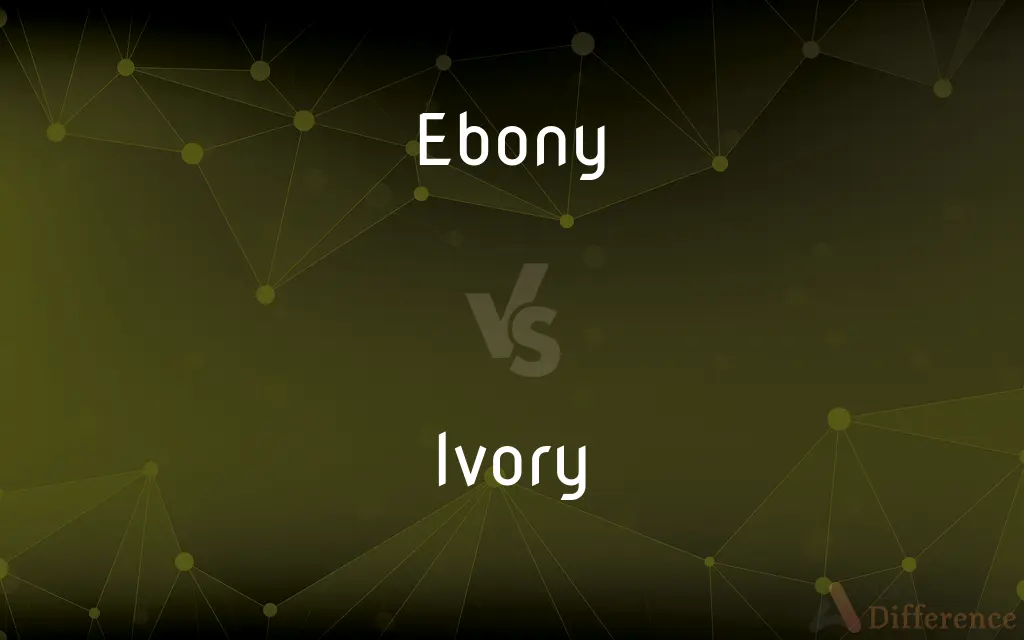Ebony vs. Ivory — What's the Difference?
By Tayyaba Rehman & Urooj Arif — Updated on April 4, 2024
Ebony is a dense black hardwood, known for its durability and smooth finish, whereas ivory is a hard, white material from animal tusks, valued for its beauty and rarity.

Difference Between Ebony and Ivory
Table of Contents
ADVERTISEMENT
Key Differences
Ebony and ivory, though both prized for their aesthetic and material qualities, hail from vastly different sources. Ebony is a type of wood obtained from several species of the genus Diospyros, while ivory primarily comes from the tusks of elephants and, to a lesser extent, from other animals like walruses and narwhals. This fundamental difference in origin shapes their use, cultural significance, and conservation issues.
The color of ebony is one of its most defining features, offering a deep, rich black that is both natural and uniform, making it highly sought after for fine furniture, musical instruments, and decorative items. Ivory, on the other hand, is renowned for its smooth texture and lustrous white color, qualities that have made it a preferred material for sculpture, piano keys, and ornamental objects. The contrast between ebony's dark tone and ivory's light hue has also been symbolically significant in art and literature, often representing duality or harmony.
In terms of physical properties, ebony is known for its extreme density and hardness, which allow it to be polished to a high sheen, making it resistant to damage and wear. Ivory, while also durable, has a slightly porous structure and requires more maintenance to retain its beauty over time. Both materials are valued for their ability to stand the test of time, but their maintenance and care differ due to these inherent properties.
The harvesting and trade of both ebony and ivory have raised significant ethical and environmental concerns. Ebony trees are slow-growing, leading to overharvesting and the depletion of native populations in some areas. Ivory trade, on the other hand, has been linked to the poaching of elephants, threatening their survival. Consequently, international regulations and conservation efforts are in place to protect these species and regulate their trade.
Despite their differences, both ebony and ivory have historically been symbols of luxury and status. Their unique qualities have endeared them to craftsmen and artists for centuries, making items made from these materials highly prized and often symbolic of wealth and refinement. Today, ethical sourcing and sustainability are increasingly important considerations in the use and trade of ebony and ivory, reflecting a growing awareness of environmental and conservation issues.
ADVERTISEMENT
Comparison Chart
Origin
Hardwood from Diospyros trees.
Hard material from the tusks of elephants, etc.
Color
Deep, rich black.
Lustrous, smooth white.
Durability
Extremely dense and hard, resistant to damage.
Durable but requires more maintenance.
Symbolism
Often represents strength, power.
Historically symbolizes purity, luxury.
Environmental and Ethical Concerns
Overharvesting depletes native populations.
Poaching and ethical concerns over animal welfare.
Compare with Definitions
Ebony
Dense black hardwood.
The ebony chess pieces were heavy and cold to the touch.
Ivory
Requires careful maintenance.
To prevent yellowing, the ivory was kept out of direct sunlight.
Ebony
Valued for durability.
The antique ebony desk retained its polish for centuries.
Ivory
Conservation concerns.
The sale of ivory items was restricted to protect elephant populations.
Ebony
Symbol of luxury.
An ebony cane, topped with silver, was a sign of opulence.
Ivory
Hard white material from tusks.
The ivory figurine was carved with astonishing detail.
Ebony
Rich in color.
The craftsman chose ebony for its stark contrast to the maple inlay.
Ivory
Symbol of purity.
Ivory, with its smooth, white surface, often symbolizes innocence.
Ebony
Environmentally sensitive.
He only sourced ebony from sustainable forests to avoid contributing to deforestation.
Ivory
Prized for beauty.
Ivory keys were once considered a hallmark of fine pianos.
Ebony
Ebony is a dense black/brown hardwood, most commonly yielded by several species in the genus Diospyros, which also contains the persimmons. Ebony is dense enough to sink in water.
Ivory
Ivory is a hard, white material from the tusks (traditionally from elephants) and teeth of animals, that consists mainly of dentine, one of the physical structures of teeth and tusks. The chemical structure of the teeth and tusks of mammals is the same, regardless of the species of origin.
Ebony
Heavy blackish or very dark brown timber from a mainly tropical tree.
Ivory
A hard creamy-white substance composing the main part of the tusks of an elephant, walrus, or narwhal, often (especially formerly) used to make ornaments and other articles
A dagger with an ivory handle
Ebony
A tree of tropical and warm-temperate regions which produces ebony.
Ivory
The creamy-white colour of ivory
An ivory silk blouse
Ebony
Any of various tropical Asian or African trees of the genus Diospyros.
Ivory
A hard, smooth, yellowish-white substance composed primarily of dentin that forms the tusks of the elephant.
Ebony
The wood of such a tree, especially the hard black heartwood of D. ebenum or certain other species, used in cabinetwork and inlaying and for piano keys.
Ivory
A similar substance forming the tusks or teeth of certain other mammals, such as the walrus.
Ebony
The hard dark wood of various other trees.
Ivory
A tusk, especially an elephant's tusk.
Ebony
The color black; ebon.
Ivory
An article made of ivory.
Ebony
Made of or suggesting ebony.
Ivory
A substance resembling ivory.
Ebony
Black in color.
Ivory
A pale or grayish yellow to yellowish white.
Ebony
(uncountable) A hard, dense, deep black wood from various subtropical and tropical trees, especially of the genus Diospyros.
Ivory
(Music) Piano keys.
Ebony
(countable) A tree that yields such wood.
Ivory
(Games) Dice.
Ebony
A deep, dark black colour.
Ivory
(Slang) The teeth.
Ebony
A black key on a piano or other keyboard instrument.
Ivory
Composed or constructed of ivory.
Ebony
Made of ebony wood.
Ivory
Of a pale or grayish yellow to yellowish white.
Ebony
A deep, dark black colour.
Ivory
(uncountable) The hard white form of dentin which forms the tusks of elephants, walruses and other animals.
Ebony
Dark-skinned; black; especially in reference to African-Americans.
Ivory
A creamy white color, the color of ivory.
Ebony
A hard, heavy, and durable wood, which admits of a fine polish or gloss. The usual color is black, but it also occurs red or green.
Ivory
Something made from or resembling ivory.
Ebony
Made of ebony, or resembling ebony; black; as, an ebony countenance.
This ebony bird beguiling my sad fancy into smiling.
Ivory
The teeth.
Ebony
A very dark black
Ivory
The keys of a piano.
To tickle the ivories
Ebony
Hard dark-colored heartwood of the ebony tree; used in cabinetwork and for piano keys
Ivory
(slang) A white person.
Ebony
Tropical tree of southern Asia having hard dark-colored heartwood used in cabinetwork
Ivory
(informal) A die object bearing numbers, thrown in games of chance.
Ebony
Very dark black
Ivory
Made of ivory.
Ivory
Resembling or having the colour of ivory.
Ivory
The hard, white, opaque, fine-grained substance constituting the tusks of the elephant. It is a variety of dentine, characterized by the minuteness and close arrangement of the tubes, as also by their double flexure. It is used in manufacturing articles of ornament or utility.
Ivory
The tusks themselves of the elephant, etc.
Ivory
Any carving executed in ivory.
Ivory
Teeth; as, to show one's ivories.
Ivory
A hard smooth ivory colored dentine that makes up most of the tusks of elephants and walruses
Ivory
A shade of white the color of bleached bones
Common Curiosities
Are there ethical concerns with using ebony and ivory?
Yes, the overharvesting of ebony and the poaching of elephants for ivory have raised significant environmental and ethical concerns.
What is ebony used for?
Ebony is used for making musical instruments, fine furniture, and decorative items due to its density and beauty.
What makes ebony and ivory symbols of luxury?
Their rarity, beauty, and the skill required to craft them into fine objects have made both materials symbols of wealth and refinement.
Why is ivory valued?
Ivory is valued for its smooth texture, beauty, and the intricate carvings it allows, symbolizing luxury and status.
Can ebony and ivory be sourced sustainably?
Sustainable sourcing is possible through certified programs and regulations aimed at conservation and ethical trade.
What are the main sources of ivory?
The main sources of ivory are the tusks of elephants, although walruses, narwhals, and other animals also produce it.
How do the physical properties of ebony and ivory differ?
Ebony is extremely dense and hard, making it durable and resistant to damage, while ivory is slightly porous and requires more maintenance.
How does the color of ebony and ivory influence their use?
The deep black of ebony and the lustrous white of ivory offer visual and symbolic contrast, often used together for aesthetic and symbolic purposes.
How do conservation efforts impact the trade of ebony and ivory?
Conservation efforts have led to stricter regulations and bans on trade, especially for ivory, to protect endangered species and promote sustainability.
Can items made from ebony and ivory be considered investments?
Yes, due to their rarity, historical value, and craftsmanship, such items can be considered valuable investments.
What alternatives exist for ebony and ivory in manufacturing?
Alternatives like synthetic materials and other woods or materials that mimic the properties of ebony and ivory are increasingly used.
How do regulations affect the availability of ebony and ivory?
International regulations have limited the availability of both materials, especially ivory, to curb illegal trade and protect species.
How does the symbolism of ebony and ivory differ across cultures?
While generally symbols of luxury and purity, the specific cultural significance of ebony and ivory can vary, reflecting local beliefs and values.
Is there a difference in care between ebony and ivory items?
Yes, ebony requires less maintenance due to its density, whereas ivory needs more care to prevent yellowing and damage.
Why are ebony and ivory often mentioned together in art and literature?
Their contrasting colors and the harmony they represent when combined have made them powerful symbols in art and literature.
Share Your Discovery

Previous Comparison
Doge vs. Dove
Next Comparison
Drum vs. DrumfishAuthor Spotlight
Written by
Tayyaba RehmanTayyaba Rehman is a distinguished writer, currently serving as a primary contributor to askdifference.com. As a researcher in semantics and etymology, Tayyaba's passion for the complexity of languages and their distinctions has found a perfect home on the platform. Tayyaba delves into the intricacies of language, distinguishing between commonly confused words and phrases, thereby providing clarity for readers worldwide.
Co-written by
Urooj ArifUrooj is a skilled content writer at Ask Difference, known for her exceptional ability to simplify complex topics into engaging and informative content. With a passion for research and a flair for clear, concise writing, she consistently delivers articles that resonate with our diverse audience.















































